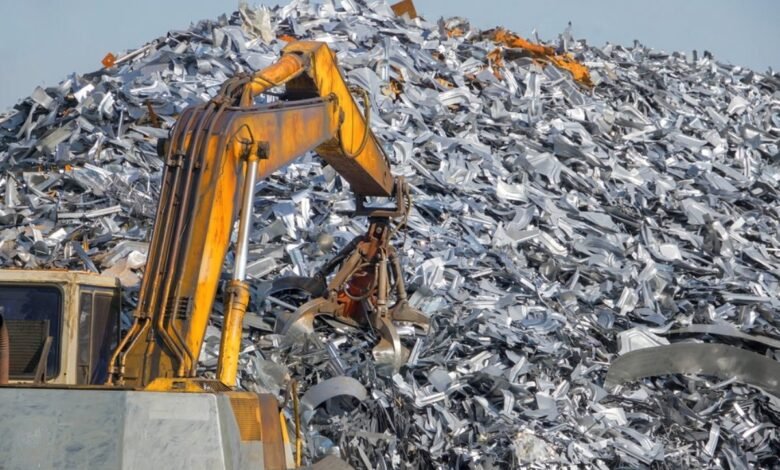What Happens to Scrap Metal After Collection?

Once scrap metal is collected from homes, businesses, or industrial sites, its journey doesn’t end there. The process of turning scrap metal into reusable material involves several important steps, from sorting and processing to melting and repurposing. This ensures that valuable metals are recycled, reducing the need for new raw material extraction and minimizing environmental impact. Here’s a detailed look at what happens to scrap metal after collection.
1. Transportation to a Scrap Yard or Recycling Facility
After scrap metal is collected, it’s transported to a scrap yard or recycling facility for further processing. The transportation process is often quick, especially when metals are collected in bulk. The scrap yard acts as a central hub where metals are sorted, weighed, and evaluated.
At the facility, the scrap metal is typically unloaded, and the first step in the recycling process begins: sorting.
2. Sorting the Scrap Metal
One of the most critical steps after collection is sorting the scrap metal into different categories. Not all metals are the same, and separating them ensures that they can be recycled effectively and efficiently.
- Ferrous Metals: These are metals that contain iron and are magnetic, like steel and cast iron. They are sorted using large magnets to separate them from non-ferrous metals.
- Non-Ferrous Metals: These are more valuable metals like aluminium, copper, brass, and stainless steel. Non-ferrous metals are not magnetic and are usually sorted by hand or with more advanced machinery.
- Contaminants and Non-Metal Materials: In some cases, metal items may contain contaminants like rubber, plastic, or wood. These non-metal components are removed during the sorting process to ensure the metals are as pure as possible.
Sorting metals helps recyclers maximize the value of the materials, and it ensures that each type of metal is processed correctly.
3. Shredding and Fragmentation
After sorting, large pieces of scrap metal are broken down into smaller, more manageable sizes. This step is essential because smaller metal fragments are easier to process during the next stages of recycling.
- Shredding: Large metal items, like cars, appliances, or structural beams, are put through industrial shredders that reduce them to small pieces. Shredding also helps separate metal from non-metal components, such as plastics or rubber found in appliances.
- Fragmentation: In some cases, metals may need to be further fragmented using air classifiers or mechanical processes to separate different types of metals, especially non-ferrous metals like aluminium and copper.
Shredding and fragmentation allow the metal to be processed more quickly, making it easier to melt and refine.
4. Melting the Scrap Metal
Once the metal is shredded and sorted, it’s ready to be melted down. The melting process occurs in large industrial furnaces designed specifically for each type of metal. For example, steel, aluminium, and copper all require different temperatures for melting.
- Ferrous Metals: Steel and iron are melted down in blast furnaces or electric arc furnaces, where the metal is heated to high temperatures to become molten.
- Non-Ferrous Metals: Metals like aluminium, copper, and brass are melted in specialized furnaces that are designed to handle their lower melting points.
The melting process can take minutes to hours depending on the size of the batch, the type of metal, and the furnace used. During melting, impurities may rise to the surface and are skimmed off to ensure the final product is as pure as possible.
5. Purification and Refining
To ensure the recycled metal is of high quality, it often undergoes a purification process after melting. This step removes any remaining impurities and ensures that the metal meets the standards required for reuse in manufacturing.
- Electrolysis: Some metals, like copper, are purified using electrolysis, where an electrical current is passed through the molten metal to separate impurities.
- Chemical Treatment: Other metals may be treated with chemicals to remove contaminants that could affect their quality during future use.
Once purified, the metal is ready to be cooled and solidified for further use.
6. Solidifying the Metal into New Shapes
After the purification process, the molten metal is poured into moulds or casts to form solid shapes. These shapes are typically standardized for easy transport and reuse in various industries.
- Bars or Ingots: Metals like steel, aluminium, and copper are often cast into large bars or ingots, which can be easily transported to manufacturers for further processing.
- Sheets or Coils: Some metals are rolled into thin sheets or coils, which are commonly used in the construction, automotive, and manufacturing industries.
The solidified metal is now in a usable form and can be shipped off to industries that will repurpose it for new products.
7. Distribution to Manufacturers
Once the scrap metal is processed into bars, sheets, or other forms, it’s ready to be sent to manufacturers who will use the recycled material to produce new products. These industries span a wide range of sectors, including:
- Construction: Recycled steel and aluminium are commonly used in building materials, infrastructure projects, and home construction.
- Automotive: The automotive industry is one of the largest consumers of recycled metals, using materials like aluminium and steel in vehicle production.
- Consumer Goods: Recycled metals are used to create everything from appliances to electronics, contributing to the production of sustainable products.
By repurposing recycled metal, manufacturers reduce the demand for new raw materials, lowering the environmental impact of mining and metal extraction.
8. Contributing to a Circular Economy
Once the scrap metal has been recycled and reused in new products, those products eventually enter the marketplace. The recycled metal may be used in everything from cars and airplanes to building structures and electronics. Over time, when these products reach the end of their life cycle, they can be collected as scrap metal once again, beginning the recycling process anew.
This cycle supports a circular economy, where materials are continuously recycled and reused, minimizing waste and conserving natural resources.




